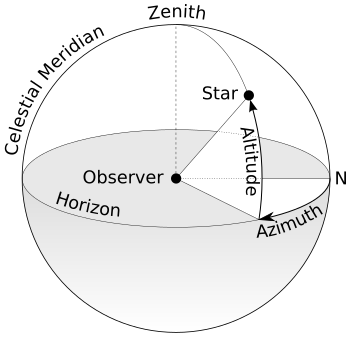Horizontal coordinate system
The horizontal coordinates are:
- Altitude (Alt), sometimes referred to as elevation, is the angle between the object and the observer's local horizon. For visible objects it is an angle between 0 degrees to 90 degrees.
- Azimuth (Az), that is the angle of the object around the horizon, usually measured from the north increasing towards the east. Exceptions are, for example, ESO's FITS convention where it is measured from the south increasing towards the west, or the FITS convention of the SDSS where it is measured from the south increasing towards the east.
- Zenith distance, the distance from directly overhead (i.e. the zenith) is sometimes used instead of altitude in some calculations using these coordinates. The zenith distance is the complement of altitude (i.e. 90°-altitude).
Contents
General observations
The horizontal coordinate system is fixed to the Earth, not the stars. Therefore, the altitude and azimuth of an object changes with time, as the object appears to drift across the sky. In addition, because the horizontal system is defined by the observer's local horizon, the same object viewed from different locations on Earth at the same time will have different values of altitude and azimuth.Horizontal coordinates are very useful for determining the rise and set times of an object in the sky. When an object's altitude is 0°, it is on the horizon. If at that moment its altitude is increasing, it is rising, but if its altitude is decreasing it is setting. However, all objects on the celestial sphere are subject to diurnal motion, which is always from east to west. One can determine whether altitude is increasing or decreasing by instead considering the azimuth of the celestial object:
- if the azimuth is between 0° and 180° (north–east–south), it is rising.
- if the azimuth is between 180° and 360° (south–west–north), it is setting.
- At the north pole all directions are south, and at the south pole all directions are north, so the azimuth is undefined in both locations. A star (or any object with fixed equatorial coordinates) has constant altitude, and therefore never rises or sets when viewed from either pole. The Sun, Moon, and planets can rise or set over the span of a year when viewed from the poles because their right ascensions and declinations are constantly changing.
- At the equator objects on the celestial poles stay at fixed points on the horizon.









0 komentar:
Posting Komentar